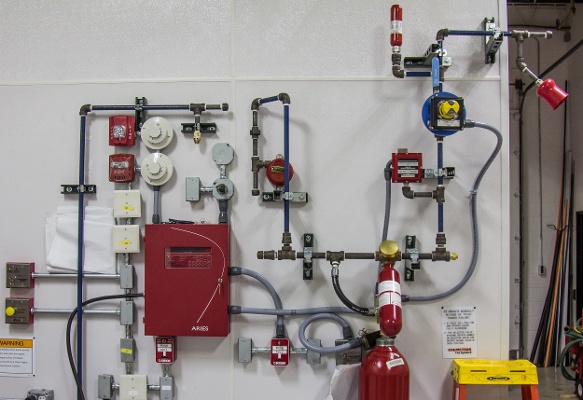What is a CO2 or Carbon Dioxide Fire Suppression System?
Fire suppression systems are designed to suppress or extinguish a fire in sensitive environments where water from a fire sprinkler is not a desired extinguishing agent. Common areas where you will find fire suppression systems include server rooms, engine rooms, flammable storage areas, museums, and data centers.
There are a few different types of agents that are used in a suppression system to suppress the fire. In server rooms and environments where you have personnel working in the area, you will usually find clean agent or inert gas suppression systems. In environments where there are few personnel or none at all, you will typically find CO2 fire suppression systems. The areas that you’ll find CO2 fire suppression systems include engine rooms, generator rooms, power stations, flammable liquid storage rooms, and around large industrial machines.
While CO2 fire suppression systems are highly effective at suppressing fires, the CO2 agent also poses a health risk when compared to the other agents. For this reason, you’ll find CO2 fire suppression systems most often in non-occupied environments.
How does a CO2 Fire Suppression System Put Out a Fire?
A fire needs oxygen, fuel, and heat to continue to burn. By eliminating one of these three elements, a fire can be suppressed or extinguished. While some suppression agents reduce the heat of the fire, a CO2 fire suppression system eliminates the oxygen to suppress the fire. When the suppression system detects smoke or fire, it then releases the CO2 agent into the space it is protecting. The CO2 level in the space quickly increases as the oxygen level quickly drops causing the fire to be suppressed or extinguished.
CO2 is a colorless, odorless, and electrically non-conductive gas that leaves no residue behind. This means any sensitive equipment that is in the protected space is not damaged by the CO2, which reduces downtime and costs. Once the CO2 has dispersed to safe levels from the protected space, personnel can access any damage from the fire or smoke and quickly get back to work with no cleanup needed.
Is a CO2 Fire Suppression System Dangerous?
At 7.5% concentration, CO2 can cause asphyxiation to humans. Most CO2 fire suppression systems are designed to have 34% CO2 concentrations for a total flood of the protected space. Due to the obvious dangers of CO2, the CO2 fire suppression systems are required to have certain life safety devices to protect personnel around or near the protected spaces. One of the life safety devices is a pneumatic siren that warns people around the area that the CO2 will be discharging from the suppression system. It is important to properly train all personnel on the dangers of the CO2 fire suppression system and how to evacuate safely if the system is preparing to dump the CO2 to suppress the fire.
Have More Questions About CO2 Fire Suppression Systems?
To learn more about CO2 fire suppression systems, contact Koorsen Fire & Security today. Koorsen's fire suppression experts can help answer any questions you may have about CO2 and other types of fire suppression systems. Koorsen has extensive experience in designing, installing, inspecting, and maintaining fire suppression systems for businesses in all industries.



